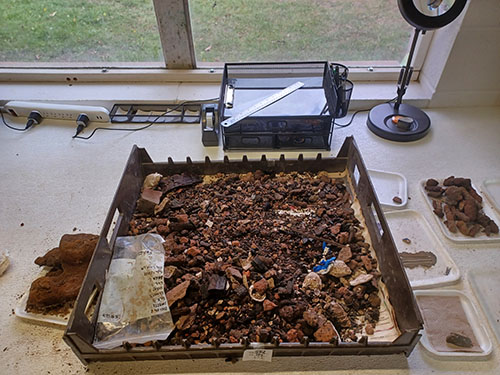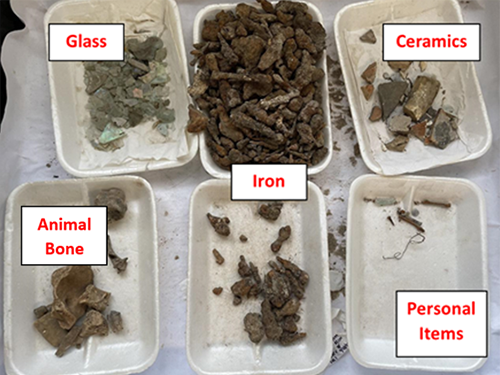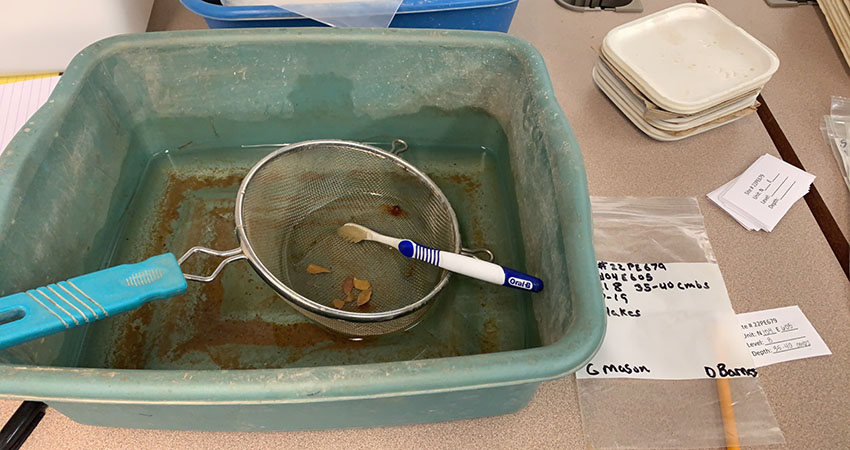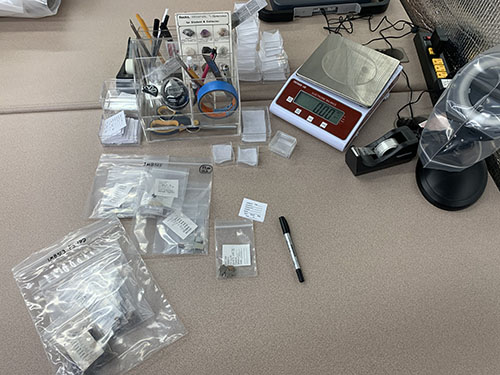The Archaeologist’s Toolkit: Lab Processing
Posted on March 14, 2023 by Chelsea Cook
Many people imagine archaeologists spend a majority of their time out in the field. However, you might be surprised to find out that we actually spend more time in the lab. In general, for every one day spent in the field, we spend at least 3 days in the lab. We are currently excavating 15 sites for the I-10 Mobile River Bridge Archaeological Project, and just one of those sites produced over 15,000 artifacts. Each of these artifacts are cleaned, catalogued, and analyzed in the lab. This blog follows an artifact’s journey through our lab to explore this time-consuming process.
When artifacts arrive in the lab, they are laid out to dry on a tray. Each group of artifacts is labeled with their provenience, or where on the site they were recovered. Next, the artifacts are rough sorted, or grouped by type. For our project, we group artifacts into glass; ceramics; metal; building materials, like brick and mortar; organic materials like animal bone, wood, and botanicals; and lithics, or rocks.


Rough sorting artifacts: before (left) and after (right).
Next, artifacts are washed. The process is surprisingly low-tech: certain artifacts, such as glass and ceramics, are washed gently with a toothbrush and water until most of the dirt is removed. These objects must be dealt with delicately -scrubbing too hard can remove a design on a ceramic fragment or the patina on a glass shard. Other artifacts, such as bone, iron, and charcoal cannot be washed due to their fragility.

Washing artifacts with a toothbrush and water. A colander is used to make sure artifacts aren’t lost in the dirty water!
Once they are washed and dried, the artifacts are ready to be inventoried. Each artifact is entered into a database along with its attributes, such as count, weight, and dimensions. Artifacts are stored in clear plastic bags, which are labeled with information about the artifact and the site where it was recovered (below). The database allows us to keep track of each artifact and to conduct analyses on our dataset.

In progress inventory of artifacts recovered from the I-10 Mobile River Bridge Archaeological Project.
At the end of the project, the artifacts are stored in a curation facility. These storage areas are designed to ensure long-term preservation of the artifacts. The facilities are climate-controlled, and artifact boxes are stored on raised shelves to protect from critters or flooding. These artifacts belong to everyone; by storing them in an organized and accessible manner, we make them available for future research or for museum displays.
Though curation of artifacts marks the end of its time in our lab, it is not the end of its archaeological journey. After lab processing is done, we draw conclusions based on the data we gathered and publish our findings. We not only make our findings available to colleagues within the archaeological community, but also share results with the public. Stay tuned as we continue to share results from our current work on the I-10 Mobile River Bridge Archaeology Project!
Further Reading on Lab Processes:
What do Archaeologists do: The Society for American Archaeology provides a brief over view of what archaeologists for in the lab and how they preserve collections.
Steps of Archeology :The National Park Service provides a brief description of the different steps of archaeology, including lab processing, cataloging and curation, and analyzing and interpreting data.
Labratory Process of the Mississippi Valley Archaeology Center: A brief description of the laboratory processes in place at the Mississippi Valley Archaeology Center in Wisconsin.
The Archaeologist’s Toolkit is a blog series written by Anthropology student Chelsea Cook. This series explores archaeological concepts and methods.
Blog 1: What is Archaeology? - A brief introduction and busting the common myths about archaeologists.
Blog 2: What is Stratigraphy? – Travel through time with a brief introduction the archaeological laws of stratigraphy.
Blog 3: What is Archaeological Survey? – Learn about some of the various methods archaeologist employ when looking for an archaeological site.
Blog 4: What is an Excavation? – Learn what an archaeological excavation is as well as the different methods that can be used.


